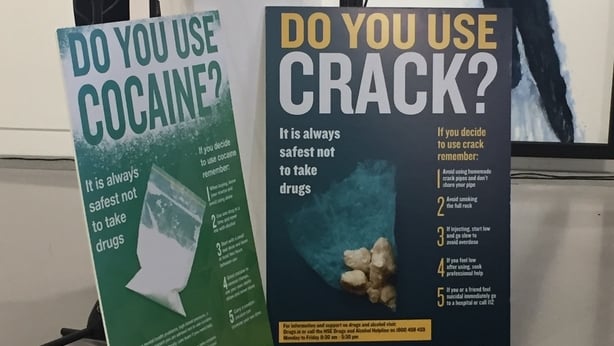A new campaign by the Ana Liffey Drug Project and the Health Service Executive aims to raise awareness about the dangers of using cocaine.
Cocaine use and cocaine-related deaths have increased and there has been a marked increase in crack cocaine use in Ireland.
Since last year, a number of communities have reported seeing an increase in crack cocaine use and more people are presenting with crack cocaine as their drug of choice.
It is reported that the price of crack cocaine in Dublin city has reduced to €20-€25 per rock, meaning that it is more accessible to people who could not have otherwise afforded it.
The #DoYouUseCocaine awareness campaign was launched this morning by Minister of State for Health Promotion and the National Drugs Strategy, Catherine Byrne.
The campaign aims to raise awareness about the dangers of using cocaine and how to reduce the harms associated with snorting, smoking or injecting cocaine.
The HSE said cocaine was more available and at its highest purity in Europe today than it had been in a decade.
It is the most commonly used illicit stimulant drug in Europe and Ireland ranks fourth highest in EU for use of cocaine among young adults.
Three out of ten Irish people aged between 15-64 state that they have used illicit drugs such as cannabis, MDMA or cocaine in their lifetime.
The clear message at today’s launch was that it was always safest not to take unknown or illicit drugs.

However, if a person chooses to take cocaine they are urged to follow harm-reduction advice. This includes the advice that the risks are greatly increased if cocaine is used in combination with other substances, including alcohol.
Dr Eamon Keenan, the @HSELive 's National Clinical lead for Addiction Services, has drawn parallels between the increase in cocaine use and Ireland's return to affluence. pic.twitter.com/6GJU1wednV
— RTÉ Politics (@rtepolitics) July 17, 2018
Almost all deaths (93%) where cocaine was implicated in 2015 involved other drugs.
Minister Byrne said: "Recent figures which show an increase in those seeking treatment for cocaine use is of real concern. This evidence supports what we are hearing from some services on the ground that cocaine use, and in particular crack cocaine use, is on the rise."
Cocaine remains the third most common drug reported among people presenting to treatment in Ireland.
Since 2014, there has been a steady increase in the proportion of new cases for treatment reporting cocaine as a main problem drug in Ireland, rising from a low of 297 cases in 2013 to 568 cases in 2016.
Irish data shows an increase in cocaine-related deaths during the economic boom years and a decrease following the recessionary period.
Following a decline in cocaine-related deaths from 2008-2012, figures began to rise again in 2013 and in 2015 there were 44 deaths recorded.
HSE National Clinical lead for Addiction Services Dr Eamon Keenan said: "During the time of the Celtic Tiger we saw a steep rise in cocaine use. That dropped off after 2008. Between 2008 and 2013, there was a reduction in people presenting.
Dr Eamon Keenan, the @HSELive 's National Clinical lead for Addiction Services, has drawn parallels between the increase in cocaine use and Ireland's return to affluence. pic.twitter.com/6GJU1wednV
— RTÉ Politics (@rtepolitics) July 17, 2018
"Since then we have seen that increasing and it is that people have more money in their pocket. During the fallow period, people may well have been using other substances.
"But now they have become more affluent and there is more money available, [they] are turning back to use cocaine and that is why we are seeing the increase in the number of people who are presenting for cocaine misuse. In 2016, we had 568 new cases presenting with cocaine problems to our services."





